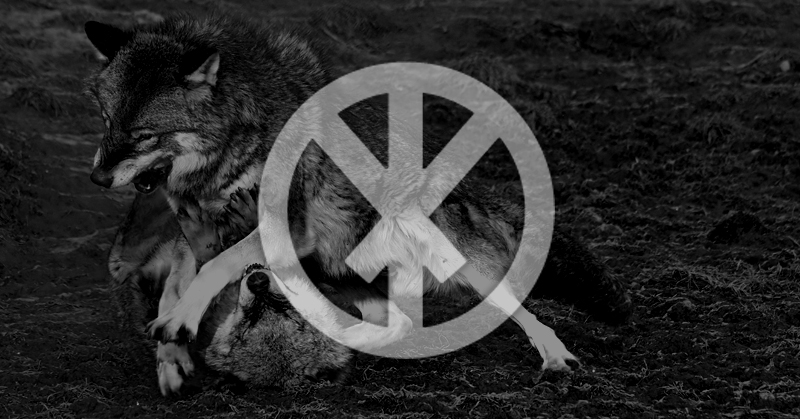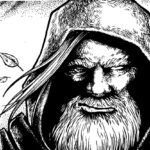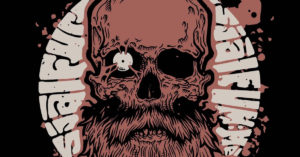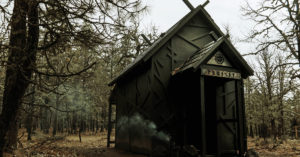The Conflict Bindrune

Several readers have asked about the meaning of the Conflict Bindrune that appears on the back cover of Becoming a Barbarian.
In the opening chapter of Becoming a Barbarian, I made the point (as I have in several other essays and speeches) that masculinity is action-oriented. Masculinity reaches its most perfect form in life-or-death conflict — in a battle between the individual man and the natural world, which includes other men. This does not mean that there are no other aspects of masculinity, or that masculinity is absent in the absence of conflict. It simply means that if you conceptually map out the differences between male and female humans at their extreme opposite points, the perfect feminine nurtures life and the perfect masculine fights.
It is tempting to say that the perfect masculine fights for human life or to defend human life. That argument could be framed in evolutionary and biological terms, but this seems unnecessary. Adding that hint of heroic narrative to something so primal seems bound to touch off a pointless circle-jerk about how noble and valorous men are for doing what they want to do anyway. Men often fight for the sake of fighting, or for personal gain, and in some sense this is genetic competition that supports life. But it is more truthful to say that masculinity in its most perfect form is about fighting, and leave it at that.
It could also be argued more broadly that living itself is a form of conflict. As I wrote in Becoming a Barbarian:
“All of our life stories are a collection of highs and lows, of victories and defeats, of struggles and overcoming. Without conflict, no life story is worth telling. Without conflict and struggle, the answer to the question ‘What happened?’ is: ‘Nothing.’
Like Odin and Thor, we know we will die, but unless we fight, we are already as good as dead.
Better to live vigorously, better to fight, than to simply wait for the end…in peace.”
The conflict bindrune is essentially an inverted peace sign, used to illustrate this point. It is a synthesis of contemporary and ancient symbols that results in a new symbol that captures a basic human truth about men and life that is too easily forgotten in this age of safety and comfort facilitated by wealth and technology.
The conflict bindrune was designed to visually convey this truth:
“Life is Conflict. Peace is Death.”
For a more thorough rationale, let’s examine the components of the symbol and their history.
The Peace Sign
The peace sign is a powerful contemporary symbol — one of the most easily recognized and well-known symbols in the world. Almost everyone knows that it means, “peace.”
A friend recently reminded me that peace could technically mean anything from armistice to genocide. This is accurate, and good for a chuckle. Peace could mean the total annihilation of your enemy. That would, after all, resolve a conflict. Permanently.
But to most, the peace sign and the word “peace” are anti-violent. They represent a commitment to apparently non-violent resolutions, and a rejection of the human truth that, “Violence is Golden,” although in practice peace-oriented measures like gun control always require the threat of violent enforcement.
The contemporary peace sign has always been associated with disarmament. It was originally designed in Britain in 1958 using the semaphore signals for “N” and “D,” to stand for Nuclear Disarmament, to be used in a campaign for same. It was conceived as a symbol of despair, and was theoretically inspired by a mis-remembering of a Goya painting depicting the execution of a peasant. (The peasant’s hands actually point upwards in the original painting.)
The original designer eventually realized and regretted that he had based the symbol for peace on a symbol for death and despair, surrounded by the empty circle of the unborn child.
(I’d argue that the circle isn’t empty, because there is actually something in it.)
More on peace symbols here, and here is a 1971 Eugene, Oregon newspaper clipping in which a woman identifies the peace sign as a runic symbol for “the death of man.”
Algiz
The runic symbol that the woman was referring to was the Elder Futhark rune named Algiz or Elhaz, which comes from a Germanic word for Elk — possibly originating from belief in a elk god. As with all runes, evidence is spotty and mysterious, and anyone who speaks of absolute meanings can only do so subjectively, for themselves. The usage and interpretation of the runes changed over time and from place to place and tribe to tribe.
It is only, to my knowledge, during World War II that the inverted Algiz rune was used widely as a death rune or Todesrune. This usage was adapted from Austrian occultist and Wotanist Guido Von List. In The Secret of the Runes, as translated by Stephen E. Flowers, the upturned Algiz is referred to as the “man” or full moon rune.
“The fifteenth rune encompasses both the exoteric and esoteric concept of the high mystery of humanity and reaches its zenith in the warning: ‘Be a man!’”
Conversely, Von List refers to the downturned Algiz (the shape used in the peace sign) as “yr” rune, sixteenth in the series. Von List associated each of the runes with the passages about runes in the Hávamál. In the Hávamál, the passage about the sixteenth has to do with changing the mind of a maiden. List links this to the fickle and changeable nature of women, as well as the mutability of the moon. He wrote:
“The yr- or error-rune [Irr-rune], which causes confusion, whether through the excitement of the passions in love, in play, in drink (intoxication), or through pretextes of speech (sophistry) or by whatever other means, will perhaps conquer resistance through confusion. But the success of a victory gained by such means is just as illusory as the victory itself — for it brings anger, wild rage, and ultimately madness. The “yr-” or “error-rune” therefore also contrasts with the “os-rune,” since it tries to force the quest of an opponent with mere pretext instead of with real reasons. Therefore, it teaches: “Think about the end.”
I transcribed List’s entire rationale here because it was especially relevant. The downturned Algiz/Yr rune symbolizes foolish error. It is also presented as anti-male and fundamentally feminine. It symbolizes the tendency of people to get carried away with foolish, flimsy ideas that, though they seem good at the time, will ultimately lead to their doom.
This does suit the “peace” movement.
Moving away from Von List, the Anglo-Saxon rune poem associates the rune with Elk:.
The Elk-sedge usually lives in the fen,
growing in the water. It wounds severely,
staining with blood any man
who makes a grab at it.
There seems to be some academic controversy regarding the association of the rune with Elk. However, the theme of danger is a continuity.
In Runelore, the widely-read Edred Thorsson associates the elk horn or sedge with the sword, and links it to the god Freyr, which brings together themes of violence and fertility, creation and destruction. Thorsson also links the rune to the divine self:
“…the splayed hand ( = protection, humanity), the horns of the solar hart lifted to the heavens in pride and potency, the swan in flight (a reference to the valkyrja), and the Germanic arm posture for prayer and invocation.”
The Old Norwegian Rune Poem associates the Algiz rune with both man and the claw of the hawk.
Man is an augmentation of the dust;
great is the claw of the hawk.
The Old Icelandic Rune Poem presents man as “the delight of man, an accumulation of dust, and the adorner of ships.”
In Summoning the Gods, Collin Cleary identifies Elhaz or Algiz as the “striving of the lower toward the higher” and the “Will To Actualization.” Expanding on Thorsson’s lead, Cleary reads Elhaz/Algiz as, “signifying the relation of the individual to the ideal.”
“A wolf does not have to be persuaded to be the best wolf it can be. It will strive to be so, and will succeed to some degree or other, contingent upon its natural endowments. Humans find their perfection in a relationship to the divine, but this relationship can be avoided, cancelled, or perverted.”
The shape of the rune itself supports this interpretation. Algiz exalts, like a man with arms directed upward to praise or acknowledge something higher.
Many people also seem to associate Algiz with protection. Structurally, it’s a strong rune, evoking posts with knee braces in timber framed buildings. It “holds the roof up.” Looping back to men, it is the role of men to protect the perimeter and those inside it. Algiz could be seen as a sentry — a symbol of that protective role.
While the history of symbols is useful, the runes are best understood as mysteries. Their meaning deepens with contemplation, in part because there is the mind game of making twenty-four or so symbols mean everything.
The peace sign is a modern symbol that means one thing to billions of people. So, in terms of direct communication, an inverted peace sign should clearly and immediately communicate the opposite of that thing to billions of people. There is power in that scale of recognition. This reality need not eliminate more esoteric understandings of the symbol, it merely adds another layer.
As a symbol of conflict, the Algiz rune signifies the nature and fate of man. Man reaches for his highest potential in conflict, becoming what he is. He fights because it is his nature, like rutting elk fighting struggling for dominance in the spring. He also fights to protect the perimeter, a sentry among sentries who defines the outer boundary and keeps the roof from caving in on everyone inside. He fights, but few men are remembered for fighting, and all men, even gods, must die and return to dust.
Tiwaz
In designing the Conflict Bindrune, I realized that as an inverted peace sign, it could simply be mistaken for a peace sign which was accidentally upturned. I wanted to make the meaning clear, so there could be no mistake, and indicate the proper orientation of the symbol. The best way to mark a direction is with an arrow, and an upward arrow is also the rune Tiwaz. By extending and crossing the arms or “knee braces” of Algiz, they form a natural arrow.
Tiwaz is directly associated with the god Týr. This only solidifies the intended meaning of the rune, as Týr is essentially a warrior god. Týr is best known for courageously sacrificing his own hand to the wolf Fenris so that the Aesir could convince the wolf to be bound. Binding the wolf protected the gods and the world, for a time, from its wild and powerful wrath. Týr volunteers to do what must be done, and make the necessary sacrifice.
So Tiwaz, in the context of the Conflict Bindrune, not only points out the proper orientation of the symbol, but also adds elements of courage, duty, and frith. Further, in the Sigrdrífumál, a valkyrie tells Sigurd that Tiwaz is a victory rune, and encourages him to carve the symbol into his sword.
A Symbol of Revolt
Timeless symbols are powerful, but new symbols are necessary. Religion and philosophy and storytelling must address the challenges and realities of every man-age. Today we live in an age where the peace sign is prominent, where boys are taught that violence is always wrong, and males are often portrayed as flawed and delinquent females. We live in an age of fear, where men not only hide behind the law, but are required by modern totalitarian surveillance states to do so, under threat of both financial ruin and violent state incarceration.
Masculinity requires danger and conflict, and it is through conflict that men become — to borrow Cleary’s words — “the best wolves they can be.” Acknowledging this natural truth in an age where the very ideas of masculinity and human nature are despised and punished is an act of spiritual revolt.
The Empire teaches that conflict is wrong. Those who adopt this symbol disagree.
They know that the peace sign is a death rune.
They understand that:
“Life is Conflict. Peace is Death.”

Note: As of this writing, two men have already had this rune tattooed on their bodies. It is taking on a life of its own. I encourage this, and there is no need to ask for my permission. I would however, appreciate credit for developing the symbol in the forms of links, citations and hashtags. I would also love to see photos of the tattoos.




